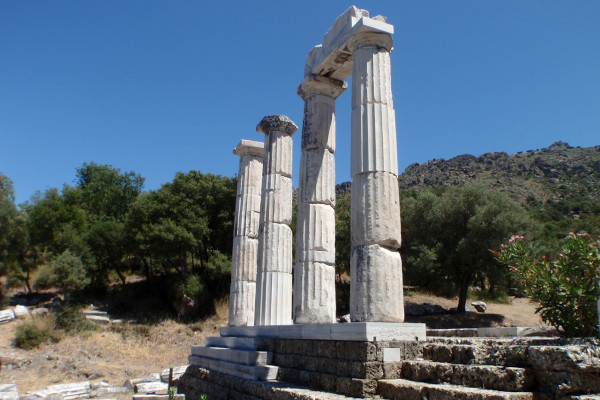Among the lush vegetation that is a general characteristic od Samothraki, the visitor can observe the relics of the ancient city of Palaiopoli. The name in the Greek language means literally "old city".
A potential tour in the area of the ancient Palaiopoli starts from the small church of Hagia Paraskevi and goes up to the cobblestoned road of the archaeological museum and the Temple of the Gods. The walls and the fortification of the city was made out of big rocks, all different size from each other and were 5-6 meters high and 2.5-4 meters wide.
The port of the Palaiopoli city was outside the city walls. According to many sources, Apostle Paul visited Samothraki on his journey from Minor Asia to Kavala. An Early Christian church was built here, the ruins of which can be observed in the east part of the ancient port.
During medieval times the family of Genoa Gattilusi built a new and stronger defensive wall to protect the city, not only from the Turks but from the Venetians as well. The fortress had a moat, a precinct, and three towers, but only one of them still exists.
The ancient city was inhabited until the Byzantine years, while most of the ruins are buried under the dense vegetation that covers most of the island.
The Kaveiria Sacraments of Samothraki
The sacraments of Samothraki were very important religious events in all ancient Greece. The greatest spread of the mysteries was during the 3rd century BC and the favorable environment that was established during the Macedonian rule. Many people consider them as equal to the famous sacraments of Elefsina, probably the most important of all Greece.
Historians argue that the Kaveiria sacraments were so important that many kings, rulers, and politicians were visiting the remote and isolated island of Samothraki in order to take part and become members of the closed community of the sacraments. There is a legend that during those sacraments Philippos the Second and Olympiada, the parents of Alexander the Great, first met. Another interesting detail is that in the sacraments of Samothraki, both free men and slaves could participate, in contrast to Elefsina where only free men could take part.
Fire was the main theme of the sacraments and played an important role as it was symbolizing the birth and rebirth of man. The most important characteristic, though, was the absolute secrecy. All participants were taking a vow of silence and talking about sacraments of Kaveiria or revealing the followed processes was punished by death.
The birth place of Nike
Nike was a goddess of Greek mythology. Her father was Pallantas, her mother was Styga and her brothers and sisters were Zelos, Kratos, and Via, which mean zeal, power, and violence respectively. According to the myth, Nike and her brothers and sisters were Zeus' esquires from the first moment he became the leader of all gods of Olympus.
Nike was the representative of Zeus in cases of a victory, she used to offer libations or she was present when a winner was crowned with a wreath of olive branches. For this reason, sculptors always made statues of a tall woman with huge wings on her shoulders and back.
Nike of Samothraki was found in the temple of Kaveiria by Greek workers who were excavating on this spot on behalf of the French consul. When the statue was discovered, the French embassy arranged the transfer of the statue in Paris. It is made of marble and it is 3,28 meters high. It is kept in the Louvre museum in Paris, placed in a prominent position and along with Aphrodite of Milos and Mona Liza of Leonardo da Vinci are considered to be the most important exhibits of the museum.
